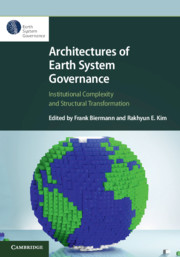Book contents
- Architectures of Earth System Governance
- Series page
- Architectures of Earth System Governance
- Copyright page
- Contents
- Contributors
- Acknowledgements
- 1 Architectures of Earth System Governance
- Part I The Building Blocks
- Part II Core Structural Features
- Part III Policy Responses
- Part IV Future Directions
- Glossary
- Index
- References
1 - Architectures of Earth System Governance
Setting the Stage
Published online by Cambridge University Press: 17 April 2020
- Architectures of Earth System Governance
- Series page
- Architectures of Earth System Governance
- Copyright page
- Contents
- Contributors
- Acknowledgements
- 1 Architectures of Earth System Governance
- Part I The Building Blocks
- Part II Core Structural Features
- Part III Policy Responses
- Part IV Future Directions
- Glossary
- Index
- References
Summary
Over the past decades, international institutions, such as treaties and regimes, have proliferated in global governance, and we have seen a tremendous amount of studies on their emergence, maintenance and effectiveness. Increasingly it has become evident, however, that such institutions do not operate in a void but within complex webs of larger governance settings. These large web-like structures, or ‘governance architectures’, are important to understand because they shape, enable and at times hinder the functioning of single international institutions and are crucial variables in determining the overall effectiveness of global governance. In recent years, this concept of governance architecture has effectively shifted the debate to situations in which an area is regulated by multiple institutions and norms in complex settings. This introductory chapter offers conceptual clarity about global governance architectures and their structural features as well as an overview of key insights gained through the last decade of research. We also identify key methodological approaches, challenges, and advances in this field of study.
Keywords
- Type
- Chapter
- Information
- Architectures of Earth System GovernanceInstitutional Complexity and Structural Transformation, pp. 1 - 34Publisher: Cambridge University PressPrint publication year: 2020
References
- 5
- Cited by



